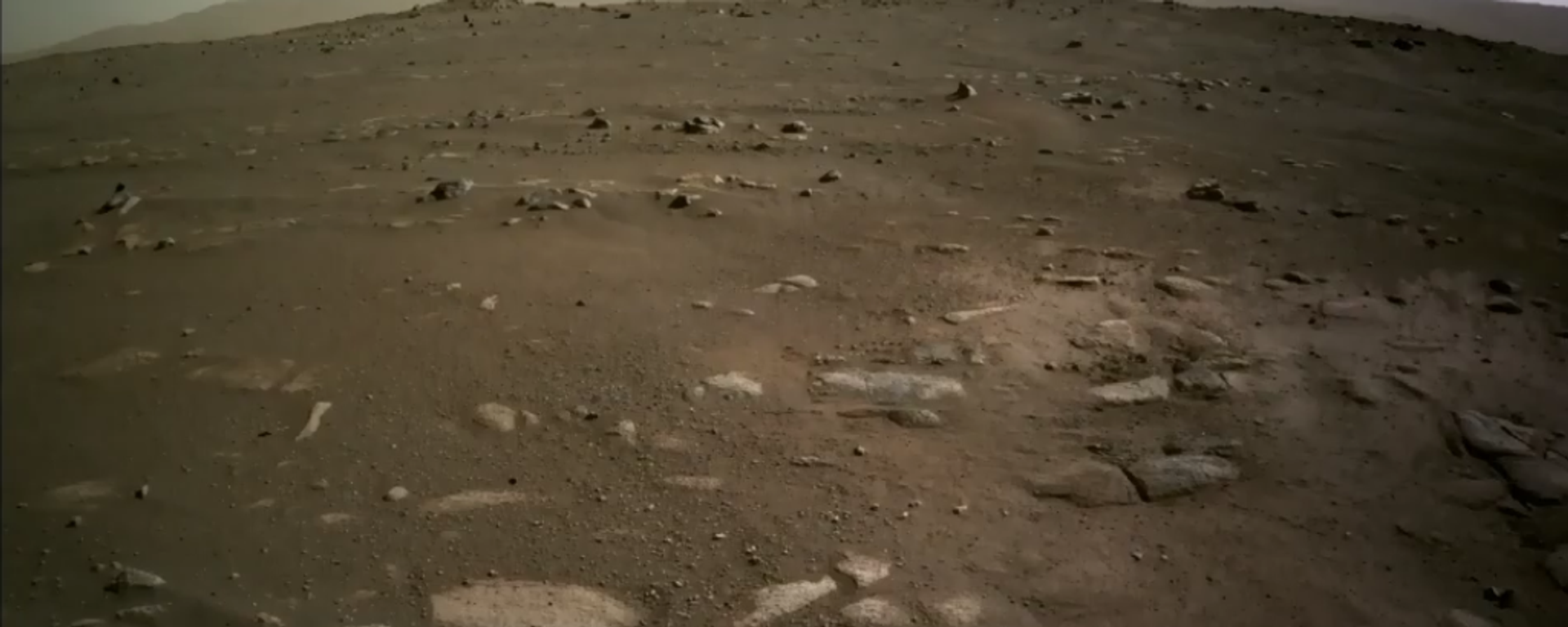https://sputnikglobe.com/20230519/perseverance-rover-sends-first-images-of-mars-belva-crater-1110450813.html
Perseverance Rover Sends First Images of Mars' Belva Crater
Perseverance Rover Sends First Images of Mars' Belva Crater
Sputnik International
NASA's Perseverance Mars rover has captured a stunning mosaic of images using its Mastcam-Z instrument, providing valuable insights into the Jezero Crater's interior.
2023-05-19T01:37+0000
2023-05-19T01:37+0000
2023-06-20T17:11+0000
beyond politics
science & tech
mars
nasa
perseverance
space
space exploration
https://cdn1.img.sputnikglobe.com/img/07e7/05/13/1110450650_3823:0:6177:1324_1920x0_80_0_0_8757104aa20d11dfe207fdf12d0af90c.jpg
Newly released footage by NASA has offered a stunning glimpse of Mars' Belva Crater, and more specifically the inner workings of the crater itself. A total of 152 images were stitched together to make up the image.The images, taken on April 22 during the 772nd Martian day of the mission, reveal exposed bedrock and sedimentary layers that slope steeply downward. It also doubles down on earlier suggestions on the presence of a large Martian sandbar that formed billions of years ago when a river channel flowed into the lake that once existed in the Jezero Crater.The rover's science team believes the large boulders in the foreground may be remnants of bedrock exposed by the meteorite impact or transported into the crater by the ancient river system.To aid in analyzing the geological features, the mission also created a 3D version of the mosaic known as an anaglyph. This visualization allows scientists to better understand the relationships between the crater wall outcrops and provides an immersive experience.Perseverance's primary objective is astrobiology, including the search for signs of ancient microbial life. The rover will continue to study Mars' geology and past climate, paving the way for human exploration and collecting samples that may contain evidence of microbial life.Future missions, in collaboration with the European Space Agency (ESA), will retrieve these samples and bring them back to Earth for detailed analysis.The Mars 2020 Perseverance mission aligns with NASA's Moon to Mars exploration approach, which includes the Artemis missions to the Moon to prepare for future human missions to Mars. The Jet Propulsion Laboratory (JPL), managed by Caltech for NASA, built and operates the Perseverance rover.
https://sputnikglobe.com/20230513/nasas-perseverance-rover-produces-first-evidence-of-wild-martian-river-1110308021.html
https://sputnikglobe.com/20220727/nasa-planning-to-bring-mars-samples-to-earth-in-2033-1097863772.html
mars
Sputnik International
feedback@sputniknews.com
+74956456601
MIA „Rossiya Segodnya“
2023
News
en_EN
Sputnik International
feedback@sputniknews.com
+74956456601
MIA „Rossiya Segodnya“
Sputnik International
feedback@sputniknews.com
+74956456601
MIA „Rossiya Segodnya“
nasa's perseverance mars rover, perseverance rover, mastcam-z, mars belva crater, space photo images, the jet propulsion laboratory
nasa's perseverance mars rover, perseverance rover, mastcam-z, mars belva crater, space photo images, the jet propulsion laboratory
Perseverance Rover Sends First Images of Mars' Belva Crater
01:37 GMT 19.05.2023 (Updated: 17:11 GMT 20.06.2023) NASA's Perseverance rover on Mars has captured a mosaic of images using its Mastcam-Z instrument, providing valuable insights into the Jezero Crater's interior. The images were taken while the rover was positioned near a large impact crater within Jezero Crater.
Newly released footage by NASA has offered a stunning glimpse of Mars' Belva Crater, and more specifically the inner workings of the crater itself. A total of 152 images were stitched together to make up the image.
The images, taken on April 22 during the 772nd Martian day of the mission, reveal exposed bedrock and sedimentary layers that slope steeply downward. It also doubles down on earlier suggestions on the presence of a large Martian sandbar that formed billions of years ago when a river channel flowed into the lake that once existed in the Jezero Crater.
"Mars rover missions usually end up exploring bedrock in small, flat exposures in the immediate workspace of the rover," said Katie Stack Morgan, deputy project scientist of Perseverance at NASA’s Jet Propulsion Laboratory in Southern California. "That’s why our science team was so keen to image and study Belva. Impact craters can offer grand views and vertical cuts that provide important clues to the origin of these rocks with a perspective and at a scale that we don’t usually experience."
The rover's science team believes the large boulders in the foreground may be remnants of bedrock exposed by the meteorite impact or transported into the crater by the ancient river system.
To aid in analyzing the geological features, the mission also created a 3D version of the mosaic known as an anaglyph. This visualization allows scientists to better understand the relationships between the crater wall outcrops and provides an immersive experience.
"An anaglyph can help us visualize the geologic relationships between the crater wall outcrops," said Stack. "But it also provides an opportunity to simply enjoy an awesome view. When I look at this mosaic through red-blue 3D glasses, I’m transported to the western rim of Belva, and I wonder what future astronauts would be thinking if they were to stand where Perseverance once stood when it took this shot."
Perseverance's primary objective is astrobiology, including the search for signs of ancient microbial life. The rover will continue to study Mars' geology and past climate, paving the way for human exploration and collecting samples that may contain evidence of microbial life.
Future missions, in collaboration with the European Space Agency (ESA), will retrieve these samples and
bring them back to Earth for detailed analysis.
The Mars 2020 Perseverance mission aligns with NASA's Moon to Mars exploration approach, which includes the Artemis missions to the Moon to prepare for future human missions to Mars. The Jet Propulsion Laboratory (JPL), managed by Caltech for NASA, built and operates the Perseverance rover.




